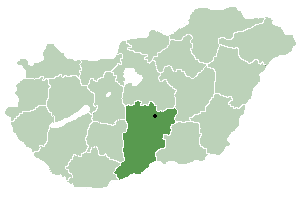El Puesto (Tinogasta) | |
|---|---|
Municipality and village | |
| Country | |
| Province | Catamarca Province |
| Time zone | UTC−3 (ART) |
El Puesto (Tinogasta) is a village and municipality in Catamarca Province in northwestern Argentina. [1]
El Puesto (Tinogasta) | |
|---|---|
Municipality and village | |
| Country | |
| Province | Catamarca Province |
| Time zone | UTC−3 (ART) |
El Puesto (Tinogasta) is a village and municipality in Catamarca Province in northwestern Argentina. [1]

Moorends is a village in the north-east of the City of Doncaster, South Yorkshire, England, situated on the border with East Yorkshire and Lincolnshire. It was historically part of the West Riding of Yorkshire until 1974. It is part of the civil parish of Thorne, which lies to the south.

Pálmonostora is a village in Bács-Kiskun county, in the Southern Great Plain region of southern Hungary.

Manzanal del Barco is a municipality located in the province of Zamora, Castile and León, Spain. According to the 2004 census (INE), the municipality has a population of 194 inhabitants.
Zbydniów is a village in the administrative district of Gmina Zaleszany, within Stalowa Wola County, Subcarpathian Voivodeship, in south-eastern Poland. It lies approximately 4 kilometres (2 mi) south-east of Zaleszany, 9 km (6 mi) north-west of Stalowa Wola, and 67 km (42 mi) north of the regional capital Rzeszów.
The Sloping Island Group is a group of small islands in south-eastern Tasmania in Australia. They lie close to the south-eastern coast of Tasmania around the Tasman and Forestier Peninsulas.
Ibiquera is a municipality in the state of Bahia in the North-East region of Brazil.
Bertolínia is a municipality in the state of Piauí in the Northeast region of Brazil.
Vilelas is a municipality and village in Santiago del Estero Province in Argentina.
La Ramadita is a town and municipality in Catamarca Province in northwestern Argentina.
Pampa Blanca is a town and municipality in Catamarca Province in northwestern Argentina.
On the continent of Antarctica, the Aramis Range is the third range south in the Prince Charles Mountains, situated 11 miles southeast of the Porthos Range and extending for about 30 miles in a southwest–northeast direction. It was first visited in January 1957 by Australian National Antarctic Research Expeditions (ANARE) southern party led by W.G. Bewsher, who named it for a character in Alexandre Dumas' novel The Three Musketeers, the most popular book read on the southern journey.
Õrsava is a village in Setomaa Parish, Võru County in southeastern Estonia.
Kabalapur (Bharmyanatti) is a village in Belgaum district in Karnataka, India.
Ward Islands is a group of two small islands and off-lying rocks forming the southern part of the Amiot Islands, off the southwest part of Adelaide Island. Named by the United Kingdom Antarctic Place-Names Committee (UK-APC) for Herbert G.V. Ward, Chief Engineer of RRS John Biscoe, 1948–1962, which ship assisted the Royal Navy Hydrographic Survey Unit which charted this group in 1963.
Moider Glacier is a glacier flowing west into the east side of Dalgliesh Bay, Pourquoi Pas Island, in Marguerite Bay, Antarctica. It was named by the UK Antarctic Place-Names Committee in 1979 in association with nearby Perplex Ridge; the word "moider" can be a synonym for "perplex".
Gomez Nunatak is an isolated nunatak 40 nautical miles (74 km) southwest of Mount Vang, surmounting the interior ice plateau near the base of the Antarctic Peninsula. It was mapped by the United States Geological Survey from ground surveys and U.S. Navy air photos, 1961–67, and was named by the Advisory Committee on Antarctic Names for Jose M. Gomez, a mechanic with the Eights Station winter party in 1965.
Milestone Bluff is a rock-faced, snow-backed bluff rising to about 830 metres (2,720 ft) just west-southwest of Mount Liotard, in the south part of Adelaide Island, Antarctica. it was so named by the UK Antarctic Place-Names Committee in 1964 because the bluff is an important landmark on the inland route north of Adelaide station.
Regent Reef is an area of submerged and drying rocks forming the northeast limit of the Dion Islands, off the south end of Adelaide Island. Charted by the Royal Navy Hydrographic Survey Unit in 1963. The name given by the United Kingdom Antarctic Place-Names Committee (UK-APC) extends those in the neighboring islands associated with an emperor's court.